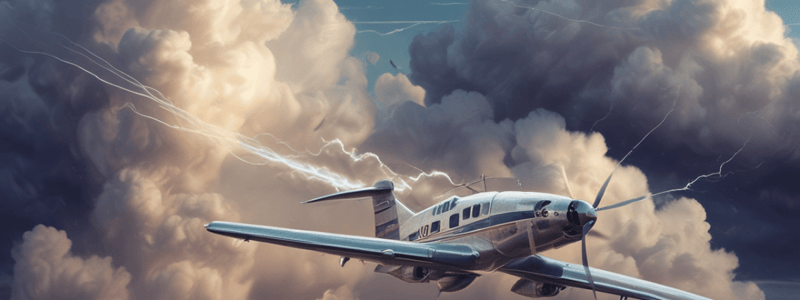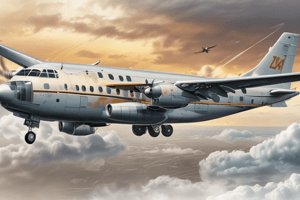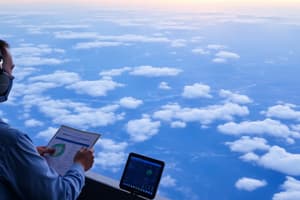Podcast
Questions and Answers
What altitude is indicated on Radar altitude?
What altitude is indicated on Radar altitude?
- FL
- MSL
- PA
- AGL (correct)
If you cannot avoid encountering thunderstorms(TS), what should you do?
If you cannot avoid encountering thunderstorms(TS), what should you do?
- Turn back immediately
- Descend below the turbulence
- Gain altitude quickly
- Maintain altitude and suitable power (correct)
During a CDFA approach with BARO and LNAV, what occurs if the temperature decreases?
During a CDFA approach with BARO and LNAV, what occurs if the temperature decreases?
- Approach will be shallow (correct)
- Approach will be standard
- Approach will be steep
- No impact on approach
What is the angle between surface wind and isobar and what is the wind speed for that surface wind?
What is the angle between surface wind and isobar and what is the wind speed for that surface wind?
When interpreting the GFA for an XC flight, which conditions might you expect?
When interpreting the GFA for an XC flight, which conditions might you expect?
Where do large supercooled water droplets form?
Where do large supercooled water droplets form?
Flashcards are hidden until you start studying
Study Notes
Radar Altitude
- Radar altitude is measured as Above Ground Level (AGL).
Thunderstorm Encounter
- If unable to avoid a thunderstorm, maintain current altitude and suitable power settings.
- Do not attempt to turn back during the encounter.
CDFA Approach with Temperature Variation
- Conducting a Constant Descent Final Approach (CDFA) using Barometric and LNAV systems can result in a shallower approach when the temperature decreases.
Surface Wind and Isobar Relationship
- The angle between surface wind and isobar is 0 degrees.
- At this angle, the wind speed is typically 30 knots.
GFA Flight Considerations
- During a cross-country flight with given General Forecast Areas (GFA), expect to encounter moderate to severe turbulence and moderate icing.
- Identifying moderate icing on the GFA may be challenging; pay attention to specific symbols.
Large Super Water Drops
- Large supercooled water drops may occur in conditions without an aloft freezing level.
- Avoid choices involving freezing levels or clear ice when selecting options related to supercooled water drops.
Studying That Suits You
Use AI to generate personalized quizzes and flashcards to suit your learning preferences.




